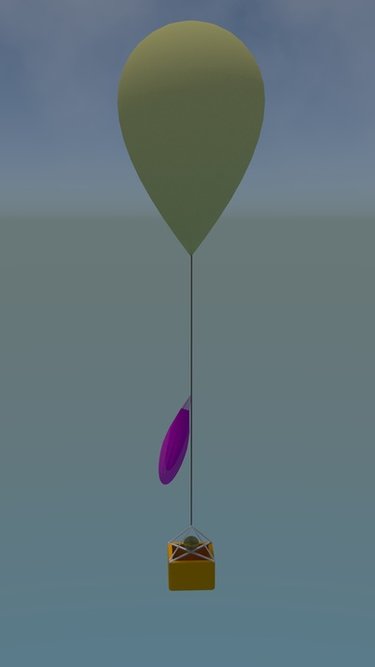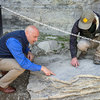AP physics students reach for the stars
VOORHEESVILLE — Voorheesville teacher Ted Simons’s Advanced Placement physics students hope to complete their year-long project this June, as they launch a camera-laden weather balloon into near space to measure the curvature of the Earth.
“To reach 100,000 feet with our balloon is our ultimate goal,” high school senior Alexandra Cunningham told The Enterprise.
Simons said that he had not assigned a project of this magnitude to students before.
“It’s uncharted waters,” he told The Enterprise. AP students doing college-level work, take their final test in May, and then usually finish the year out with smaller projects and papers, he said.
“It’s dry and horrible,” Simons said of the usual tasks. For this year’s project, he said, “I introduced it Day One. They’ve chipped away at it all year.”
Simons left all other explanations to his students, as he did at the school board meeting Monday. Students gave a presentation about their assignment, called Project Icarus, to the board, and informed the board about their proposed mid-June launch date and budget, while requesting permission for a field trip to go retrieve their equipment.
Board member Doreen Saia, an attorney, asked the students specifics about plans to recover, and possibly abort, the launch depending on conditions that could hold the district liable. Students assured Saia they have a plan.
“I wish you all the success with it,” said board member Diana Straut.
The board asked the students to share their results at its June meeting.
Project Icarus
The students’ task was to design an experiment to send up in a balloon, they said.
“We decided what our strengths were as a group,” Cunningham told The Enterprise. “I identified as public relations.” Cunningham returned calls, gathered responses from her classmates, and compiled the information ready for outreach.
The group separated into teams handling the experiment, its design, radio and communications, and finance.
Schuyler King, of the finance group, “created a spreadsheet online, and everyone put the amounts for materials they thought they needed,” Cunningham said. The final estimate for the project is around $3,000.
“We have been approved for a Voorheesville Community and School Foundation grant,” Cunningham said. The students asked the foundation for the bulk of the costs — $2,750 — on Tuesday. The class received a $400 grant for a camera from the Voorheesville Parent Teacher Association. They also received grants from the Voorheesville Fire Department, and United Employees of Voorheesville, Cunningham said.
“We have also been in contact with local families who are considering donations for the project,” she said.
Student input
“We have already started to conduct tests on our radio equipment and a camera we have,” said Erik Patak, of the design and radio teams. Patak and his classmate, Braeden Morrison, hold ham-radio licenses, Cunningham said.
“They’re currently working on the GPS and the radio-tracking system,” she said. They hope to have two-way communication with the balloon via radio, students said.
“Our set date isn’t set yet,” she said of the proposed launch date. “We have to analyze weather patterns” to find the optimal conditions, she said.
According to Federal Aviation Administration regulations, a launch needs a 5-mile radius of clear skies, Cunningham said. The students hope to send up their balloon during the first two weeks of June. Their former ninth-grade Earth science teacher, Kenneth Young, is helping them with weather tracking, she said.
“Much of this [launch] depends on the day itself,” Patak said. “The prevailing winds are not consistent every day, so we won’t know exactly where it will land until closer to the launch date. We expect it to land in western Massachusetts or southern Vermont.”
They estimate that the balloon will ascend for 60 minutes, and descend in 30 minutes. They will track it with a GPS device in the payload, students said.
“We’re hoping to be able to retrieve it successfully,” Cunningham said.
The class is using Garmin and GoPros camera equipment to get video footage during the flight, Patak said. Cunningham said that the group may use three cameras, to allow coverage below and at the level of the balloon, and to record the curvature of the earth.
The students hope to gather data on temperature and other features of the ozone using an ozonesonde instrument, Patak said.
The meteorological balloon will have a diameter of 7 feet on the ground, but will stretch to 40 feet in the air before it pops, Cunningham said.
“The pressure will cause it to pop, and it will fall back to the Earth,” she said. The class is ordering two weather balloons online, she said.
Students said that the casement holding their equipment must be soft enough to survive a landing, but rigid enough to protect the cameras.
The group may need to seek help from police, they said, in case the balloon comes down on a highway or on private property. As seniors, most drive, and they hope to follow the flight of the balloon.
“In school labs, everything is set up for you and everything has a specific purpose and is laid out in a concise procedure,” Patak said. “Here, we have to engineer ways to make our electronics work with one another for a real-life situation that holds some weight, not only for us, but for the community.”
Elementary school and sixth-grade students in Voorheesville will also participate in the project.
“Our younger peers will be asked to design and construct experiments to be part of the payload,” said physics student Ben Mackay, of the outreach and design teams. The experiments will offer “a valuable, hands-on experience in engineering and science,” he said.
“As graduating seniors in AP physics, most of us will go on to pursue science-related careers,” said Hanna Suib, who worked on the public relations team. “A hands-on project of this scale — dealing with everything real scientists deal with, [like] budgeting and public relations — is probably better preparation than any science experiment we've done in school before.”
“I think the best part of the project is that Mr. Simons really insisted that we figure it all out by ourselves. In a typical high school class, this kind of freedom is rare,” Suib said.




